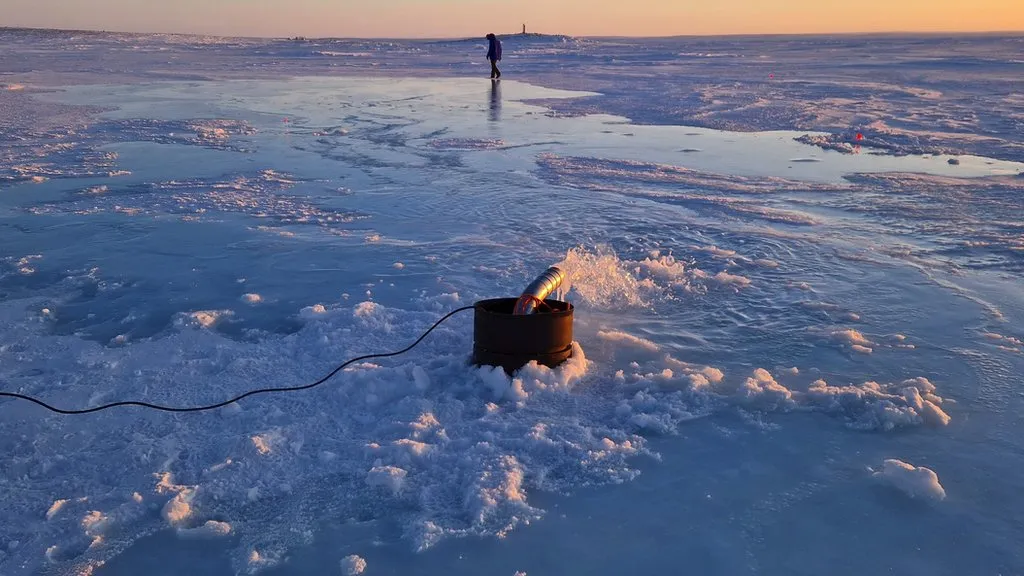The Arctic’s Desperate Measures: Geoengineering’s Controversial Bid to Preserve Sea Ice
In the vast, unforgiving expanse of the Arctic, a group of scientists huddled against biting winds, testing a radical hypothesis: could they save the melting Arctic sea ice by manually thickening it?
This scene, more fitting of a science fiction narrative, unfolds in real life off Canada’s northern shores, where researchers from the University of Cambridge’s Centre for Climate Repair engage in a high-stakes experiment with the potential to either offer a lifeline to our warming planet or pose a profound ecological risk.
The Science of Saving Ice
As the polar ice vanishes, the dark ocean below absorbs more sunlight, further accelerating global warming. The Cambridge team, led by Dr. Shaun Fitzgerald, aims to reverse this dire feedback loop by artificially enhancing the ice’s thickness. Their method? Pumping seawater over the existing ice to promote additional freezing. This innovative, albeit unorthodox, method stems from a sense of urgency as the Arctic faces precipitous declines in ice coverage, a trend starkly evident since the 1980s.
Dr. Fitzgerald and his colleagues brave extreme conditions in Cambridge Bay, a remote village within the Arctic Circle, to test their theory. They use wind to propel pumps that draw seawater, which, when spread over the ice and exposed to the harsh Arctic air, freezes, adding layers to the existing ice.

Skepticism and Scientific Debate
However, this geoengineering effort is mired in controversy and skepticism. Many scientists argue that such measures distract from the essential task of reducing carbon emissions—the root cause of global warming. Martin Siegert, a renowned glaciologist from the University of Exeter, represents a significant contingent of the scientific community who doubt the feasibility of such projects. He highlights logistical nightmares, such as the need for millions of wind-powered pumps to make a dent in the problem, and the potentially quicker melting of the artificially saltier ice during summer.
Moreover, there’s an ethical dimension to these interventions. Julienne Stroeve, a professor at University College London, critiques the scale of implementation required as “quite insane,” suggesting that meddling on such a grand scale could disrupt delicate Arctic ecosystems and alter ocean chemistry.

The Larger Implications of Geoengineering
The broader geoengineering landscape includes even more extreme suggestions, like enhancing cloud reflectivity or mimicking volcanic eruptions to block sunlight. These strategies, while imaginative, carry significant risks, including disrupting global weather patterns—a concern echoed by the UN’s climate bodies.
Critics like Lili Fuhr from the Center for International Environmental Law argue that geoengineering technologies introduce new uncertainties and could harm ecosystems and communities. Moreover, they fear that such projects provide a dangerous distraction, allowing fossil fuel interests to push off meaningful action on climate change.

The Way Forward: Caution and Moderation
Despite these criticisms, the Arctic researchers emphasize their commitment to caution. Dr. Fitzgerald insists that their project is exploratory, aiming to gather more information before any broader application is considered. This measured approach seeks to balance innovation with responsibility, acknowledging that while geoengineering could be part of the solution to climate change, it is certainly no panacea.
As the debate continues, the reality remains stark. Projections suggest that the Arctic Ocean might experience ice-free summers by 2050, if not sooner. This looming timeline compels the scientific community to explore all possible solutions, even those as bold and controversial as artificially thickening sea ice.
While the prospect of geoengineering offers a tantalizing “quick fix” to climate woes, it underscores a more profound necessity: the urgent, unambiguous need to reduce carbon emissions. Only through comprehensive, global efforts to address the source of climate change can we hope to mitigate its most severe consequences, preserving not just the Arctic, but the planet for future generations.
